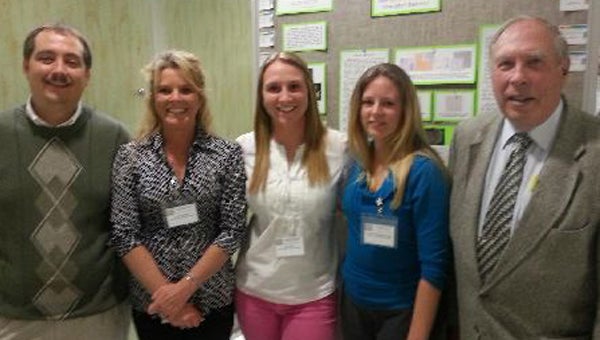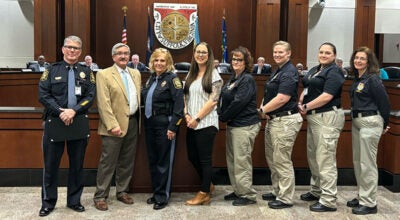Students present research at conference
Published 8:02 pm Saturday, December 20, 2014

PDCCC nursing students who attended the 2014 annual meeting of the Virginia Chapter of the American Society for Microbiology are, from left, Anthony Thomas, Cynthia Thibeault, Ashley Storrs, Elizabeth Whitfield, and microbiology mentor and professor Dr. Carl Vermeulen. (Submitted Photo)
Four Paul D. Camp Community College nursing students and their microbiology mentor and professor, Dr. Carl Vermeulen, presented fresh research findings at a prestigious meeting that is rarely attended by community colleges. In fact, PDCCC was the only community college presenting at the annual meeting of the Virginia Chapter of the American Society for Microbiology held at James Madison University on Nov. 7.
“This year, the PDCCC contingent presented their work in the midst of about 40 other groups that were mostly juniors and seniors in colleges and universities,” said Vermeulen. “Thus, these PDCCC lower division students stand proud among these upperclassmen.
“The ASM presentations are not science fair competitions for prizes, but true scientific revealings of original research that have never been done before anywhere.” He said. The findings and processes were presented by the students — on behalf of themselves and dozens of fellow former and present students — on three microbiological subjects that impact everyone.
Cynthia Thibeault told of her group’s discovery that when pre-menopausal women eat dairy products, within about 90 minutes, great numbers of the probiotic, “dairy bacteria,” in the food quickly get transported through their bodies to be secreted out in their sweat — over about two weeks of their monthly cycle.
“While this might sound disgusting,” Thibeault relates, “it is just these bacteria, which act like guard dogs that protect our skin from many infections.” Thibeault was also surprised to learn that this also occurs with milk in nursing mothers. Vermeulen supported her thoughts by telling how very little of the “normal” is studied because we tend to study sickness and try to cure diseases.
Ashley Storrs said that her work is linked to Thibeault’s because it could be asked how women got the bacteria in the first place to put into their milk to help their infants’ survivals. “You have to eat your raw greens, because my group showed that the spongy interior of all leaves (called mesophyll) is composed of cells that are coated with these dairy bacteria.” Storrs noted that the same way the bacteria protect babies, they also protect leaves from getting infected by dust-borne environmental germs. “Our group showed that these dairy bacteria isolated from leaves retards or inhibits the growth of most other kinds of bacteria,” she said.
Elizabeth “LeeAnn” Whitfield and her group are on track to save lives by the millions by being able to provide nearly a billion people and their livestock with vaccines that would not require refrigeration for storage or during transportation to remote areas in the world. This was a project that was begun more than a year ago, when its first phase was reported at an international meeting of the organization in 2013 by Anthony “Wayne” Thomas.
Last year Thomas reported that something as sensitive to heat as an enzyme can be packaged in a way that protected its molecules from heat’s distortions. He found that when enzymes are shrink-wrapped in dried starch “noodles,” the enzymes remained active up to a hot 160 degrees Fahrenheit and held at that temperature for as much as three months.
“My group wanted to see if this work could be extended to an even more complicated protein than Thomas’ simple lactase, the enzyme used by people who are lactose intolerant,” said Whitfield. “We selected human pregnancy hormone, hCG, which is many times larger than lactase, and consists of two pieces. We shrink-wrapped our hCG in flavorless gelatin, cut out “noodles” and dried them. The day before the meeting in Harrisonburg, we tested a “noodle” that had been heated at 140 degrees Fahrenheit for five months, and it still gave a positive pregnancy test.” “If not shrink-wrapped,” Vermeulen added, “the hCG lost its ‘pregnancy’ within seconds when exposed to 140 degrees.”
When asked about what should be done next, Whitfield recommended that a real vaccine be tested in chickens. They have made some shrink-wrapped meningitis vaccine in starch “noodles.” Bits of them would be placed under the skin of chickens. Within minutes the starch will be digested and the vaccine would escape into the chicken’s system. “Interestingly,” Whitfield said, “chickens make immunity antibodies just like people do, but chickens also put their antibodies in their egg whites. That makes for easy collection.”
The American Society for Microbiology, ASM, is the largest basic science society in the world. It interests encompass basic bacteriology and virology, infectious diseases, immunity, food sanitation, and many other health care activities. On the state level, the Virginia Chapter meets annually at various institutions around the state.
For more information regarding these studies and more, visit Vermeulen’s website, www.science-projects.com.






